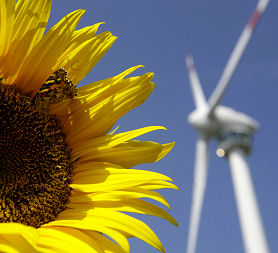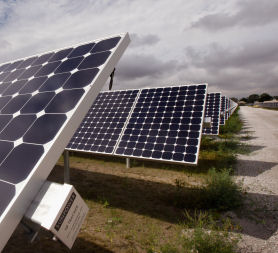Ten ideas to save the planet: wind, waves and sun
Wind turbines, tidal barrages and solar power are crucial in harnessing renewable energy. But which holds the greatest prospect in reducing emissions and preventing climate change? We ask the experts.

What idea policy or technology holds the greatest promise for tackling climate change? That was the question Channel 4 News posed to the scientific community over the past few weeks.
Thanks to the extensive contacts of the Science Media Centre at the Royal Institution Channel 4 News was able to email hundreds of scientists across various fields of expertise to sound-out their opinions.
Many agreed that harnessing the Earth’s natural elements – wind, waves and sun – was crucial in reducing emissions and producing green energy.
However, despite government backing for thousands of new offshore wind turbines to run homes across Britain by 2020, few of the scientists who responded endorsed wind power.
This could be perhaps because it’s not a “new” idea but other scientists felt a technology like wind power doesn’t yet “scale” – i.e. can be feasibly ramped-up to meet realistic levels of global energy demand – and shouldn’t therefore be their top pick.
Professor John Dominy from the University of Nottingham said: “Wind farms simply give us a warm feeling that someone, somewhere, has a firm hand on the tiller.”
The predictable power of tidal currents, some of the scientists said, is more beneficial for the environment and economy.
Climate change: 10 ideas to save the planet
The pull of the current
Professor David Elliott from the Open University proposed that tidal turbines could supply 20 per cent of the UK’s electricity.
“Tidal current turbines could tap a major new renewable energy flow,” he said.
“Tidal turbines use tidal flows. They are freestanding and have much lower eco impacts than tidal barrages – basically they are underwater wind turbines rather than hydro dam like constructions.”
The “global race is now on”, he says, to design the first fully commercial turbines in what could be a multi-billion pound market.
David Elliott from QinetiQ’s Maritime Practice agreed.
“High power marine tidal turbines are one of the best means of answering the future energy needs of the UK while also delivering substantial carbon emission reductions,” he said.
“Marine tidal energy is clean, efficient, completely predictable and not reliant on the vagaries of the weather.” David Elliot
“Marine tidal energy is clean, efficient, completely predictable and not reliant on the vagaries of the weather, thereby ensuring consistent power generation.”
Industrial-sized tidal barrages could “both generate predictable energy and lead to improvement of the environment,” said Peter Dobson from Oxford University.
However initial plans for a multi-billion pound barrage in the Severn Estuary bridging Weston-super-Mare and Cardiff were rejected earlier this year. An inquiry found that a large barrage would have a negative impact on the river’s eco-system and could “do serious damage to the estuary by wiping out around 80 per cent of the inter-tidal habitat.”
A smaller barrage has now been proposed near the Severn Bridge Crossing.

Colonising the oceans
It may seem like something from science fiction but a team of Hampshire scientists have designed a fully self-sufficient floating island ready to combat potential rising tides.
The floating city can hold up to 150,000 people and could be also used to house the rapidly growing population, Professor Carl T.F Ross from the University of Portsmouth believes.
“Apart from providing extra space, the floating islands can produce enough energy to supply their needs and to sell the surplus energy, and not to require environmentally un-friendly methods of producing energy,” he said.
Powered by wave energy and other non-fossil fuels, the island would rest on five concrete pillars which would rest securely on the sea floor.
But air could be pumped into the bottom of the pillars to make the city buoyant and allow it to be moved with the help of tug boats.

Solar power
For years solar power has revolutionised how we gather renewable energy.
Set in 25 acres of American desert, the massive solar power station Nevada Solar One uses more than 182,000 curved mirrors to absorb the sun’s rays.
The mirror fields heat oil which is then poured into radiators that extract the warmth and boil water to make steam. The steam then drives a turbine and dynamo producing as much as 64 megawatts of energy.
Professor David Elliott believes that the UK could utilise solar energy captured in deserts.
“Capture solar energy from deserts to produce electricity that can be transmitted back to Europe via undersea grid cables,” he said.
Concentrating Solar Power units, such as the mirror fields of Nevada, are effective in storing molten heat which can “allow for continued generation overnight”.
“Capture solar energy from deserts to produce electricity that can be transmitted back to Europe via undersea grid cables.” Professor David Elliott
Professor Peter White from Coventry University said that solar energy could be the only viable option for renewable energy in the UK.
“The one, and realistically only, source of renewable energy is the sun.
“It is the only renewable that can supply all our energy needs in the UK, not just electrical, without covering the whole land mass in the UK.”
As Professor Jules Pretty from the University of Essex agrees solar PV could be the future in gathering UK renewable energy.
“Put PV panels on every household and business roofs in the UK to create a distributed energy generation network,” he said.
The paper thin flexible photocells, being developed in Cambridge, could one day coat buildings and ensure the human environment is always producing its own electricity.
-
Latest news
-
Post Office Inquiry: Chairman intervenes as public gallery scoffs4m

-
Inside Sudan: An unfolding humanitarian catastrophe7m

-
What are the public spending plans for the election promises?3m

-
Michael Matheson faces Scottish parliament suspension over £11,000 iPad bill2m

-
Dudley voters divided on Rishi Sunak’s record as PM13m

-




